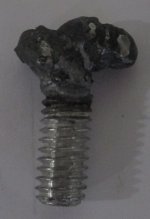I removed the head on a 1990 70hp Evinrude and 6 of the 14 bolts broke off. When I removed the head, I found that luckily the remaining bolts protruded out like studs. In the past I was able to easily remove the "studs" by using PB Blaster and a center punch and mallet to break them loose, and then removing them with a vice grip. In this case, not one has budged after trying many times. It appears that the aluminum oxide corrosion on the bolt threads do not allow the PB to penetrate down the threads (I've sprayed it 3 times a day for 5 days).
Yesterday I tried heating the aluminum around one bolt with a propane gas torch, but it seemed to cool down too quick like the heat was quickly dissipated throughout the block. How hot can I get it without damaging the block?
I tried heating the bolt then spraying it with PB to see if it would suck in the PB as it cooled, but it did nothing either. I am just heating it mildly, not heating it to where it changes color. Again, how hot can I go with heating the bolt without damaging the head, red hot?
I am go to try candle wax instead of PB.
If none of this works, I will have to take it to a welding shop, which could be costly.
Yesterday I tried heating the aluminum around one bolt with a propane gas torch, but it seemed to cool down too quick like the heat was quickly dissipated throughout the block. How hot can I get it without damaging the block?
I tried heating the bolt then spraying it with PB to see if it would suck in the PB as it cooled, but it did nothing either. I am just heating it mildly, not heating it to where it changes color. Again, how hot can I go with heating the bolt without damaging the head, red hot?
I am go to try candle wax instead of PB.
If none of this works, I will have to take it to a welding shop, which could be costly.
Last edited:




